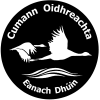Travel to Galway from Cloonboo and the Annaghdown area before 1870
By Evelyn Stevens
In 1812 the Commissioners for Enquiring into the Nature of the Bogs of Ireland published detailed maps of the Bogs, along with reports of how useful they might be for reclaiming for agricultural use. The map of the Cloonboo area shows the bogs and also the roads and houses in the area. Whether the houses are shown in their correct locations is not clear.


A map made by the Ordnance Survey in 1839 shows the houses and roads in their exact locations, with the road in the same orientation as on the bog map.
The N84 Headford Galway Road was not yet in existence, not being built until 1870. The road through the village from north to south was the boreen that goes through Greaney’s bus yard.
For people in the area to get to Galway they would have had to travel to Claregalway and on from there to Galway. This is spelled out in detail in the following letter from John Cahill of Woodpark House, written in 1822 to William Gregory, Secretary to the Lord Lieutenant:
Sir,
Permit me to suggest to you for the consideration of the Irish Government in its benevolent arrangements to relieve the distressed by public work, one of the most beneficial and necessary improvements which has ever taken place in Ireland, a Road through the great Curragh or Moore which separates this extensive and populus Wheat Country, Annadown, from the Market of Galway. The distance in a bird-eye line is about Six Miles while the road is upwards of fourteen, performing the Segment of a Circle not unlike a Horseshoe. Besides, this new Road (which has been in contempation for a Century) if produced northerly for about a Mile, would fall in with the Headford Road, and not only connect that Town but the whole County of Mayo, so much the nearer, with the Town of Galway, while the working at so essential a public improvement would relieve the poverty of the Peasantry of this Parish (the Census upwards of 7000) and enable them for ever after to avail themselves of the proximity of the Market of Galway in all weathers.
I had the honor to address you on the 8th ulto furnishing my recount of the management of your very charitable remittance to me for the relief of the distressed of Woodpark & c., and of mentioning to you the state of the two old Quays of the Harbours of Oldbury & Annadown on Lough Corrib, in the repairs of which your Engineer Mr. Nimmo, has on the 28th, authorized my expending 40 £.
I have these works in progress, and was gratified much when the Gentlemen whom Mr. Nimmo sent here last Saturday, to pay the workmen and inspect the works, assured m they consider the excavations & wharfs I am doing, admissible. I hope Mr. Nimmo will also authorize my clearing the inlets to these Harbours. I suppose Ten to Fifteen Pounds would effect it.
I have the honor to be Sir, with the most profound respect & gratitude Your very humble servt.,
John Cahill.
The alternative would have been to go west to Annaghdown or Shankill (Oldbury in Mr. Cahill’s letter) and go by boat to Galway. We all know about the boat full of people that left Annaghdown to go to Galway in 1828 but sadly sank. According to Mary Mulvihill in her book Ingenious Ireland there was a sailing fleet of trading ships on Lough Corrib run by Captain Lynch who built the lighthouse at Ballycurrin in 1775. As well as commercial traffic on the lake there was a steamer service for passengers from the 1850s. The drawing shows a steamer from Galway arriving at Nimmo’s house at Maam in 1854. (From Maria Edgeworth’s book A Tour of Connemara). It seems likely that this was one of the boats that took people and goods from Annaghdown and Shankill to Galway. The new road with its 2 bridges must have been a huge boon to the people of this area. It is hard to imagine the difference it made to them.


This article first appeared in our Winter 2019 Newsletter.




When was the map by John Murphy, Cregduff, drawn and for what purpose? Apologises if I have missed this information.
When was the map by John Murphy, Cregduff, drawn and for what purpose? Apologises if I have missed this information.